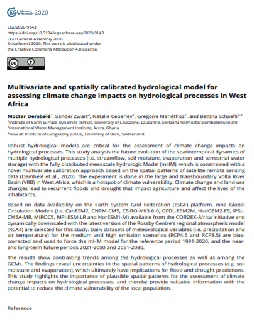Multivariate and spatially calibrated hydrological model for assessing climate change impacts on hydrological processes in West Africa
Abstract
<p>Robust hydrological models are critical for the assessment of climate change impacts on hydrological processes. This study analysis the future evolution of the spatiotemporal dynamics of multiple hydrological processes (i.e. streamflow, soil moisture, evaporation and terrestrial water storage) with the fully distributed mesoscale hydrologic Model (mHM), which is constrained with a novel multivariate calibration approach based on the spatial patterns of satellite remote sensing data (Dembélé et al., 2020). The experiment is done in the large and transboundary Volta River Basin (VRB) in West Africa, which is a hotspot of climate vulnerability. Climate change and land use changes lead to recurrent floods and drought that impact agriculture and affect the lives of the inhabitants.</p><p>Based on data availability on the Earth System Grid Federation (ESGF) platform, nine Global Circulation Models (i.e. CanESM2, CNRM-CM5, CSIRO-Mk3-6-0, GFDL-ESM2M, HadGEM2-ES, IPSL-CM5A-MR, MIROC5, MPI-ESM-LR and NorESM1-M) available from the CORDEX-Africa initiative and dynamically downscaled with the latest version of the Rossby Centre's regional atmospheric model (RCA4) are selected for this study. Daily datasets of meteorological variables (i.e. precipitation and air temperature) for the medium and high emission scenarios (RCP4.5 and RCP8.5) are bias-corrected and used to force the mHM model for the reference period 1991-2020, and the near- and long-term future periods 2021-2050 and 2051-2080.</p><p>The results show contrasting trends among the hydrological processes as well as among the GCMs. The findings reveal uncertainties in the spatial patterns of hydrological processes (e.g. soil moisture and evaporation), which ultimately have implications for flood and drought predictions. This study highlights the importance of plausible spatial patterns for the assessment of climate change impacts on hydrological processes, and thereby provide valuable information with the potential to reduce the climate vulnerability of the local population.</p><p> </p><p>Reference</p><p>Dembélé, M., Hrachowitz, M., Savenije, H., Mariéthoz, G., & Schaefli, B. (2020). Improving the predictive skill of a distributed hydrological model by calibration on spatial patterns with multiple satellite datasets. Water Resources Research.</p>

